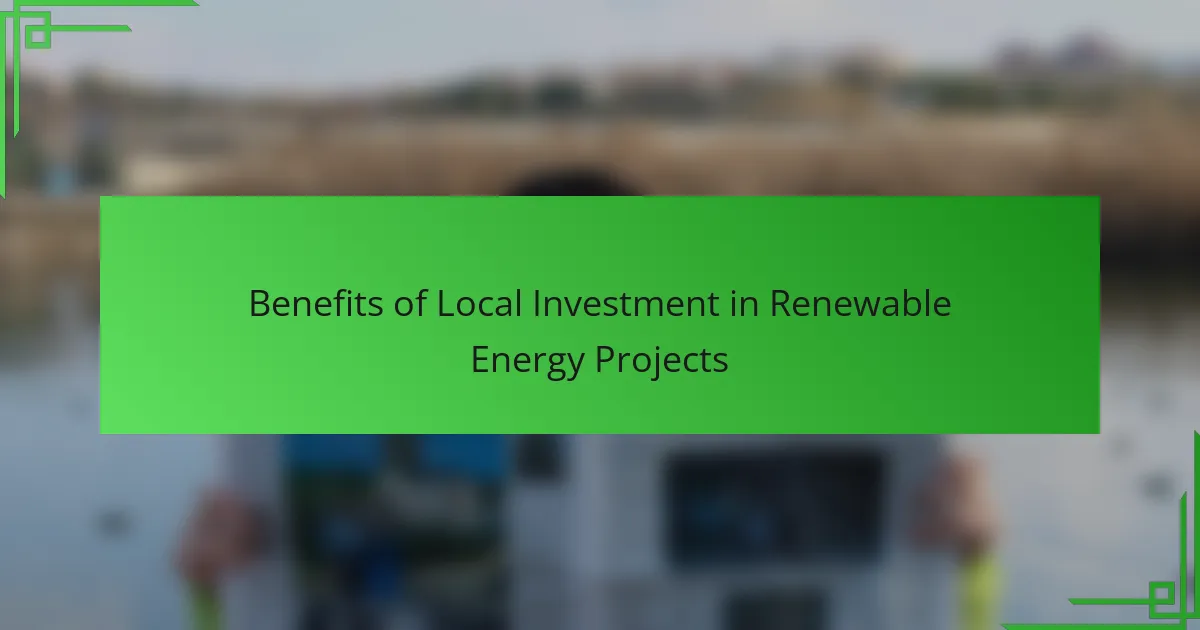Local investment in renewable energy projects significantly contributes to economic growth and job creation. These investments generate employment opportunities in areas such as construction, maintenance, and operations, with global renewable energy jobs reaching 11.5 million in 2018. Additionally, local investments enhance energy security by reducing dependence on imported fossil fuels, leading to more stable energy prices. They also support environmental sustainability by decreasing greenhouse gas emissions and fostering community engagement, which increases public awareness of energy conservation. Overall, local investments yield diverse economic, environmental, and social benefits.

What are the benefits of local investment in renewable energy projects?
Local investment in renewable energy projects leads to economic growth and job creation. It stimulates local economies by generating employment opportunities in construction, maintenance, and operations. For instance, a report from the International Renewable Energy Agency states that renewable energy jobs reached 11.5 million globally in 2018, with local projects significantly contributing to this figure.
Additionally, local investments enhance energy security. By developing renewable resources, communities reduce dependence on imported fossil fuels. This can lead to more stable energy prices. Furthermore, investing locally supports environmental sustainability. Renewable energy projects help decrease greenhouse gas emissions, contributing to climate change mitigation.
Local investments also foster community engagement and ownership. When communities invest in their energy resources, they are more likely to support and participate in sustainable practices. This can lead to increased public awareness about energy conservation. Overall, the benefits of local investment in renewable energy projects are multifaceted, encompassing economic, environmental, and social dimensions.
How does local investment impact community development?
Local investment significantly enhances community development. It stimulates economic growth by creating jobs and increasing local business opportunities. For instance, renewable energy projects often require local labor, which boosts employment rates. Additionally, these investments can lead to improved infrastructure, such as roads and utilities, benefiting the entire community. A study by the National Renewable Energy Laboratory found that local investments in renewable energy can generate up to 50% more jobs compared to non-local investments. Furthermore, local investment fosters community engagement and ownership, leading to stronger social ties. This sense of ownership often results in better maintenance and support for community projects. Overall, local investment in renewable energy is a catalyst for sustainable community development.
What economic advantages does local investment provide?
Local investment provides significant economic advantages by boosting job creation and enhancing community resilience. It stimulates the local economy by keeping financial resources within the community. This leads to increased local spending, which supports local businesses. According to the American Independent Business Alliance, locally owned businesses generate three times more economic activity than their non-local counterparts. Local investment also fosters innovation by encouraging the development of renewable energy projects tailored to community needs. Furthermore, it reduces reliance on external funding sources, which can be unstable. Overall, local investment strengthens economic stability and promotes sustainable growth in renewable energy sectors.
How does local investment enhance job creation?
Local investment enhances job creation by directing financial resources into the community. This investment stimulates economic activity, leading to the establishment of new businesses. New businesses often require employees, which directly creates job opportunities. Additionally, local investment supports existing businesses, allowing them to expand and hire more staff.
In renewable energy projects, local investment can lead to the development of infrastructure. For example, investing in solar or wind energy projects creates jobs in construction, installation, and maintenance. According to the International Renewable Energy Agency, the renewable energy sector employed over 11 million people globally in 2018, showcasing the job creation potential.
Furthermore, local investment can lead to the development of a skilled workforce. Training programs associated with renewable energy projects prepare individuals for new roles. This skill development further increases employment opportunities in the community. Overall, local investment in renewable energy projects is a powerful catalyst for job creation.
What environmental benefits arise from local investment in renewable energy?
Local investment in renewable energy leads to significant environmental benefits. It reduces greenhouse gas emissions, which are a major contributor to climate change. For instance, transitioning to solar or wind energy can decrease carbon dioxide emissions by up to 80%. Local renewable energy projects also promote biodiversity by minimizing habitat destruction compared to fossil fuel extraction. Additionally, these projects help improve air quality, leading to better public health outcomes. According to the U.S. Environmental Protection Agency, renewable energy sources can reduce air pollutants by 50%. Furthermore, local investments can enhance energy independence, decreasing reliance on imported fuels and their associated environmental impacts. Overall, local renewable energy initiatives foster sustainable practices that benefit both the environment and communities.
How does local investment contribute to reducing carbon emissions?
Local investment contributes to reducing carbon emissions by funding renewable energy projects. These projects replace fossil fuel energy sources with cleaner alternatives. For example, solar and wind energy generate electricity without emitting carbon dioxide. According to the International Renewable Energy Agency, renewable energy can reduce global carbon emissions by up to 70% by 2050. Local investments also improve energy efficiency in communities. This leads to lower energy consumption and reduced emissions. Furthermore, local projects create jobs in green technologies, fostering sustainable economic growth. Investing locally enhances community resilience against climate change impacts.
What role does local investment play in promoting sustainable practices?
Local investment plays a crucial role in promoting sustainable practices. It provides the necessary funding for renewable energy projects. This funding leads to the development of clean energy solutions. Local investments often come with a better understanding of community needs. This ensures that projects align with local environmental goals. According to the International Renewable Energy Agency, local investments in renewable energy can boost job creation. For example, a report by the U.S. Department of Energy states that local solar projects create more jobs per dollar invested than traditional energy sources. Additionally, local investment fosters community engagement and support for sustainability initiatives. This creates a positive feedback loop that enhances environmental stewardship.
How does local investment influence energy independence?
Local investment significantly enhances energy independence by funding renewable energy projects. This financial support leads to the development of local energy sources, such as solar and wind. Increased local energy production reduces reliance on imported fuels. According to the U.S. Department of Energy, local renewable energy projects can create jobs and stimulate economic growth. Additionally, local investments can lead to improved energy infrastructure. This infrastructure supports a more resilient energy system. Studies show that communities with local energy initiatives experience lower energy costs. Therefore, local investment plays a crucial role in achieving energy independence.
What are the implications of reduced reliance on fossil fuels?
Reduced reliance on fossil fuels leads to significant environmental and economic implications. It decreases greenhouse gas emissions, which contribute to climate change. For instance, transitioning to renewables could cut U.S. carbon emissions by 80% by 2050, according to the U.S. Department of Energy. This shift improves air quality, reducing health issues related to pollution. Economic implications include job creation in renewable energy sectors. The International Renewable Energy Agency reported that global renewable jobs reached 11.5 million in 2018. Additionally, reduced fossil fuel dependence enhances energy security by diversifying energy sources. Local investments in renewable energy projects stimulate regional economies and promote sustainable development.
How does local investment strengthen energy security?
Local investment strengthens energy security by increasing the availability of renewable energy sources. It reduces dependency on imported fossil fuels. Local projects can be developed more quickly than large-scale, centralized energy systems. This localization enhances resilience against supply chain disruptions. According to the International Renewable Energy Agency, local investments can create jobs and stimulate economic growth. These investments also promote technological innovation in energy production. Furthermore, they encourage community engagement and support for sustainable practices. Overall, local investment leads to a more stable and secure energy future.
What challenges might local investors face in renewable energy projects?
Local investors may face several challenges in renewable energy projects. High initial capital costs can deter investment. According to the International Renewable Energy Agency, upfront costs for solar and wind projects can exceed $1 million per megawatt. Regulatory hurdles often complicate project development. Local investors must navigate complex permitting processes that vary by location. Competition from larger firms can make it difficult for local investors to secure funding. Established companies often have more resources and access to financing. Additionally, fluctuating energy prices can impact project viability. Local investors may struggle with the uncertainty of long-term returns. Finally, technological advancements can render existing projects less competitive. Investors must stay updated on industry trends to remain viable.
What financial barriers can hinder local investment?
Financial barriers that can hinder local investment include high upfront costs, limited access to credit, and insufficient funding mechanisms. High upfront costs can deter potential investors from initiating renewable energy projects. Limited access to credit restricts the ability of local businesses to secure necessary funds for investment. Insufficient funding mechanisms, such as grants or subsidies, can further reduce financial support for local projects. According to a report by the International Renewable Energy Agency, these financial challenges are significant obstacles for local investments in renewable energy.
How do regulatory issues affect local investment opportunities?
Regulatory issues significantly impact local investment opportunities by creating barriers or incentives for investors. Strict regulations can deter investment by increasing compliance costs and uncertainty. For instance, complex permitting processes can delay project timelines. This discourages potential investors who seek quicker returns. Conversely, favorable regulations can stimulate investment by providing tax incentives or streamlined approvals. Regions with supportive policies often attract more capital. According to a report by the International Renewable Energy Agency, countries with clear regulatory frameworks see a 30% increase in renewable energy investments. Thus, the regulatory environment plays a crucial role in shaping local investment landscapes.
What strategies can enhance local investment in renewable energy projects?
Local investment in renewable energy projects can be enhanced through targeted strategies. These include creating financial incentives such as tax credits and grants for local investors. Establishing partnerships between local governments and private sectors can also foster investment. Providing educational programs about the benefits of renewable energy can increase community awareness and support. Streamlining permitting processes can reduce barriers for project development. Additionally, showcasing successful local projects can build trust and encourage further investment. Research indicates that regions with supportive policies see a 30% increase in local investment in renewable energy projects.
How can community engagement improve investment outcomes?
Community engagement can significantly improve investment outcomes by fostering trust and collaboration between investors and local stakeholders. Engaged communities are more likely to support projects, leading to smoother implementation. A study by the International Renewable Energy Agency found that projects with strong community involvement saw a 30% increase in local support. This support often translates to reduced opposition and faster permitting processes. Additionally, community engagement can enhance project sustainability through local knowledge and resources. Investors benefit from lower risks and potentially higher returns when projects align with community interests.
What partnerships are beneficial for local investors?
Partnerships with local governments and renewable energy firms are beneficial for local investors. These collaborations can provide access to incentives such as tax credits and grants. Local governments often support renewable energy initiatives, facilitating smoother project approvals. Renewable energy firms bring expertise and technology to enhance project viability.
Investors can also benefit from partnerships with community organizations. These groups can help gauge public support and engagement for projects. Additionally, collaborations with local universities can foster research and development. Such partnerships can lead to innovative solutions and workforce training.
Evidence shows that local investors in renewable energy projects often see higher returns. According to a report by the National Renewable Energy Laboratory, community solar projects yield significant economic benefits. These partnerships create jobs and stimulate local economies, making them advantageous for investors.
What are the best practices for successful local investment in renewable energy?
Successful local investment in renewable energy requires community engagement. Engaging local stakeholders fosters support and collaboration. Identifying suitable renewable energy technologies is crucial. Solar and wind projects often yield significant returns. Conducting feasibility studies ensures project viability. These studies assess local resources and energy demand. Securing funding from diverse sources enhances project stability. Grants, loans, and community financing can be effective. Establishing partnerships with local governments boosts credibility. Collaboration can streamline permitting processes and enhance visibility. Implementing transparent communication strategies builds trust. Regular updates keep stakeholders informed and engaged. Monitoring and evaluating project performance is essential. This ensures long-term sustainability and identifies areas for improvement.
How can investors assess the viability of renewable energy projects?
Investors can assess the viability of renewable energy projects by evaluating several key factors. They should analyze the project’s financial model, including projected costs, revenues, and return on investment. Investors must also consider regulatory frameworks and incentives that can impact project feasibility. Assessing the technology used is crucial, as advancements can affect efficiency and costs.
Market demand for energy produced by the project is another important factor. Investors should study local energy needs and long-term trends. Additionally, conducting a thorough risk assessment helps identify potential challenges and uncertainties.
Historical data on similar projects can provide insights into success rates and common pitfalls. According to the International Renewable Energy Agency, renewable energy projects have seen a global investment growth of 7% annually over the last decade, indicating a positive trend in viability.
What resources are available to support local investors in the renewable sector?
Local investors in the renewable sector can access various resources. Government grants and incentives provide financial support for renewable energy projects. Organizations like the U.S. Department of Energy offer funding opportunities for small businesses. Additionally, state-level programs often provide tax credits for renewable energy investments. Local chambers of commerce may also offer networking opportunities and resources. Industry associations provide valuable information and advocacy for investors. Online platforms and databases list available funding sources and investment opportunities. Research institutions may offer technical assistance and expertise for project development.
The main entity of this article is local investment in renewable energy projects. This article outlines the multifaceted benefits of such investments, including economic growth through job creation, enhanced energy security, and environmental sustainability. It discusses the impact of local investments on community development and the advantages they provide, such as reducing reliance on fossil fuels and promoting sustainable practices. Additionally, the article addresses challenges faced by local investors and strategies to enhance investment outcomes, emphasizing the importance of community engagement and partnerships.


